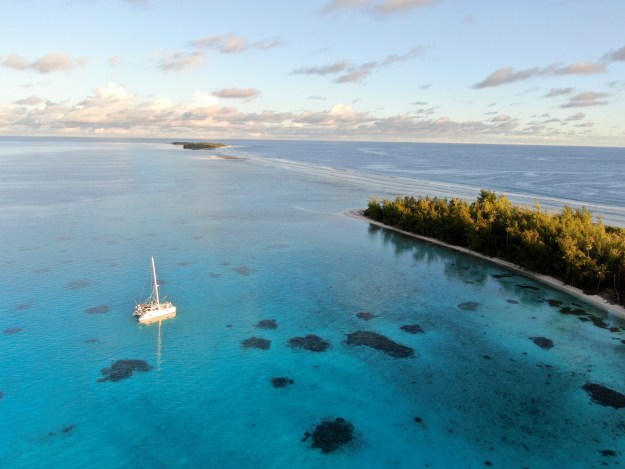Many fishermen from around the world use a “FAD” (fish aggregating device) to catch their fish. It can be a stationary or floating device. The stationary FADs are tied to something at the bottom of the sea using an extremely long line. The floating devices are attached to a beacon equipped with GPS, solar, batteries, circuit board, and sometimes depth gauges.

A FAD is a raft type float, usually made of bamboo, strong netting, loads of various sizes of line (rope), and floats. Fisherman attach the beacon to the raft so they can find it later. Small fish gather under the raft attracting larger fish which attract even larger fish. Fisherman use the GPS to track the raft, then fish for the easy prey below. Kind of like hunting using deer feeders – all cheating to me.
Anyway, won’t get into that debate. The rafts and beacons tend to end up on shore. As we walk around the windward side (Pacific Ocean side) of the motus we come across the FAD remnants. We picked up a beacon last year and tried to take it apart to see if there were any pieces we could salvage. However, that particular beacon was sealed shut with 5200 glue and was useless.
Many of our friends have retrieved the FAD beacons and scored rechargeable batteries, small solar panels, LED lights, and stainless screws. But we just did not think it was worth the trouble to lug these heavy beacons back to the boat so we usually leave them where we find them.
Try, Try, Again
Surprise, surprise. We had just walked the Puaumu motu a few days ago and did not come across any FADs. However, on this day, we came across a recently arrived FAD with a fairly new beacon attached. We removed the beacon and dragged the raft as high up on the rocks as possible (its super heavy). Trying to prevent it from going back out to sea.
Matt carried the beacon back to the boat and began the dissection.

FAD Beacon
The cover is connected with 20 stainless steel screws, nuts, and washers which can easily be reused on Sugar Shack!
After removing the clear plastic cover, we access the cute little solar panels. Maybe we can use these to create a solar powered charger for our phones? Surely there is something on google telling us to build that?

Beacon Solar Panels
Below the solar panels is the circuit board.

Circuit Board
Surrounded by a nice wood block are the batteries. The white batteries on the top row do not have numbers so we are not sure if we can use them. There are 10 soldered together. The bottom row are D batteries and unfortunately, they are not rechargeable. What a waste. There are about 15 of these batteries. The beacon also had 2 dehumidifier packs as well.

Beacon Parts
All in all, we will probably only keep the stainless-steel screws, nuts, washers, solar panels and maybe the wood. We will dispose of the rest. It was pure entertainment value.

All Beacon Parts
Check out what we did with the FAD coming up next week.
Events from this blog post occurred on 23 April, 2021. Our blog posts run 10-12 weeks behind our adventures.








 This photo gives you an idea of how very isolated we are when we visit this small piece of paradise. This shot looks at the far left (North West) corner of Puaumu.
This photo gives you an idea of how very isolated we are when we visit this small piece of paradise. This shot looks at the far left (North West) corner of Puaumu.








